What is beef chow fun?
Beef chow fun 干炒牛河 is classic Cantonese food served at the roadside as well as at most of the Cantonese restaurants. It is also a dish that assesses a chef’s skill because it is easy to make but requires specific skills to get it right.
Some gastronomes use beef chow fun as the yardstick of the standard of a restaurant. It is deemed to be of a high standard if they can consistently churn out beef chow fun with high quality.
In reality, it is a Cantonese noodle that is easy to prepare but needs some technique to be excellent. The noodles should not be oily, and ho fun is not broken into short pieces after stir-frying. The beef must be juicy and tender
Besides the beef as the main ingredient, it requires bean sprout, chives, and scallions to provide the crunchiness and freshness in contrast with the beef’s savory flavor.
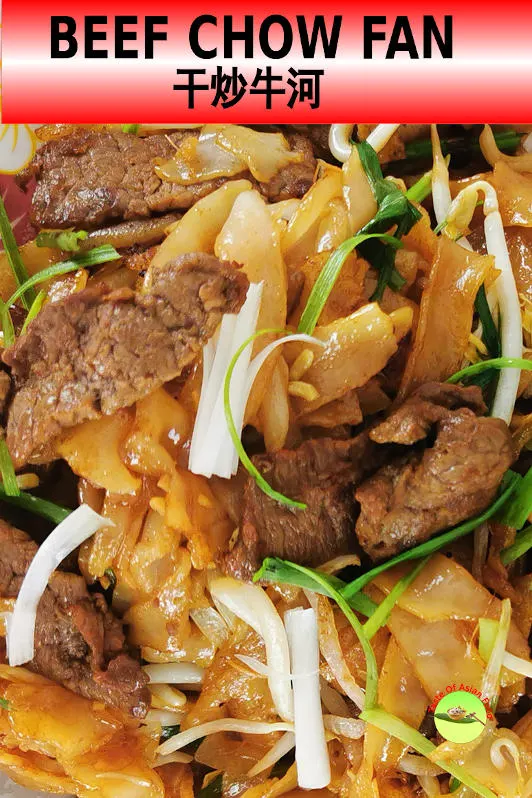
Note: This post may contain affiliate links. Please read my privacy policy for more info. I may receive commissions for purchases made through links in this post. As an Amazon Associate, I earn from qualifying purchases.
How to cook beef chow fun, Cantonese style
This post aims to provide clear instructions on how to prepare the Cantonese Style beef chow fun so that we can enjoy it without having it in the restaurant or order from takeout.
Note: You can use a thick-bottomed non-stick pan if you do not have a wok and the high-powered stove.
1. How to prepare beef chow fun
Most tender beef cuts are suitable for stir-fry, as long as sliced into thin strips. Some of the common cuts are sirloin, ribeye, and topside.
Cut the beef into slices
- Cut the beef against the grain into thin slices. Keep the beef in the freezer until half frozen. It is as easy as slicing vegetables in this state.
- Combine the beef slices with light soy sauce, baking soda by using your hand until the beef absorbs all the seasonings. Baking soda is a tenderizing agent which is used widely in the restaurant. However, it is optional and depends on how tender the cut of beef you are using.
- Combine some cornstarch and water with the beef. Keep mixing it for about one minute until the beef absorbs all the water and cornstarch. This step is essential as water keeps the meat tender and soft.
- Finally, add a tablespoon of oil and mix well. The oil will coat the beef and prevent it from sticking to the wok.
- Marinate it in the refrigerator for at least half an hour or up to four hours for the best result. It is advisable not to add salt as it will draw the water out from the meat and make it dry and tough.
Stir-fry the beef separately
The trick to making a good beef chow fun is to stir fry the beef separately. If you stir-fry the beef together with the noodles from the beginning, it will become overcooked when the noodles are ready.
Use a well seasoned to stir-fry. The beef and noodles will not stick to the surface.
Here is the method commonly used in the restaurant.
- First, heat a large ladle of oil in the wok until it starts to smoke. Pour the excess oil back to the storage container. The wok is entirely covered by a layer of hot oil now.
- When the oil hot, add the beef slices to the oil and stir-fry at moderate heat.
- Keep stirring the beef until it is about 90% cooked and no longer looks raw. Pour the beef and oil through a colander to remove the excess oil.
Beef slices treated this way is tender and juicy.
2. Cook the ho fun
What is ho fun?
The traditional beef chow fun in Hong Kong, Malaysia, and Singapore is prepared using flat white rice noodles called ho fun (also pronounce as hor fun / 河粉). Fresh ho fun are sold in wet markets and supermarkets.
Keep the freshly purchased ho fun at room temperature. The noodles will become brittle after refrigerated and break into short pieces during stir-frying. It will stay fresh at room temperature for a few days.
What if I do not have ho fun?
The flat rice noodles, ho fun are readily available in Asia but can be hard to get at certain places. It should not be a reason to dampen the spirits of making beef noodles. In fact, you can substitute it with any noodles of your choice. If you choose to replace it with dry noodles, cook it until al dente and drain off any excess water. The method remains the same, stir fry the beef and the noodles separately, then combine and finish it over high heat.
3. The seasoning used for the fried noodles
I use a relatively simple stir-fry sauce made with light soy sauce, dark soy sauce, oyster sauce, sugar, white pepper, and some Shaoxing wine. The ingredients and quantity of each can be varied considerably from one recipe to another. I notice that most of the Hong Kong versions do not include oyster sauce, but I like feel that it is more wholesome and balance to have some in the constitution. Another possible inclusion is sesame oil.
4. How to stir-fry the beef chow fun
The traditional way to prepared beef ho fun is to stir-fry with a cast iron wok over roaring heat generated by the high power stove.
Here are the steps to stir fry the ho fun:
- Loosen the ho fun. The store-bought ho fun is usually sticking together. Separate the noodles into individual strands by hand so that they will not clump together during stir-frying.
- Stir fry the ho fun with the used oil after frying the beef. Try to use less oil ad an excellent beef ho fun should not be too early when served.
- Fry the ho fun over medium to high heat to create the wok aroma (wok-hei). Pan-fry the noodles on both sides to char the noodles slightly and help to create the wok aroma.
- After that, use the tip of the spatula to stir-fry the noodles. This method prevents breaking the noodles accidentally.
- Once the ho fun turns color and rolls up slightly, add the bean sprouts in small batches.
- Keep the temperature at a constant high, and move the wok away when adding the seasoning to prevent overheating.
- Return the cooked beef along with the scallions to the wok.
- Add the seasonings and stir-fry over high heat for ten seconds.
- Dish out immediately to avoid the beef from overcooked. Serve hot.
Note:
- Bean sprouts contain plenty of water, which will wet the noodles too much and lower the temperature. As a result, it will affect the aroma of the noodles if you add all at once. You can add all at once unless you have a high power stove similar to those used in the restaurant. Otherwise, add in batches.
- You can omit the bean sprouts if you do not like the flavor, or it is unavailable. You can add some onion or other crunchy vegetables to provide a contrasting texture to the soft noodles and tender beef.
- Chinese chives call 韭黄 is best for this recipe, but it may not be available at certain places. I am using scallions as a substitute. Both scallions and chives taste best when it’s just cooked. Overcooked chives tend to become tough.
What if I do not have the high power stove and the wok?
It is ideal for stir-frying the noodles with a wok over and a high power stove. Wok stove generates high heat and is excellent to stir fry a large batch of noodles.
This restaurant method is not always possible in the home setting, especially for the homemakers who stay in an apartment. If this is the problem that you are facing, you still can produce high-quality beef chow fun with an electric stove and a large non-stick pan. It is not so much of choosing between a pan or a wok. The gold standard of the best beef chow fun must be served piping hot, enough wok aroma, less oil, and without breaking the ho fun into short pieces.
Prepare the noodles by following the above instruction with a few changes at listed below.:
- Pan-fry the marinated beef with less oil until both sides are nicely seared and brown.
- Choose a non-stick pan with a thick bottom. A heavier pan usually holds heat better. It will prevent a sudden drop in temperature, which may jeopardize the creation of the stir-frying aroma.
- Cook the noodles in small batches so that the stove can generate sufficient heat to maintain the temperature at a constant high.
If you like this recipe, I suggest you also try other similar recipes on this blog. Char Kuey Teow is the classic Malaysian Chinese fried noodles similar to beef chow fun but is prepared with cockles, Chinese sausage, pork crackles, and egg. Mee goreng is a Malaysian Indian fried noodle that is spicy. Finally, if you like ho fun, don’t ever miss to make a bowl of Ipoh chicken noodles with a unique broth simmer with chicken bones and shrimp heads.
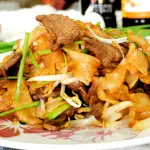
Beef Chow Fun
Beef chow fun 干炒牛河 is classic Cantonese food served at the roadside as well as at most of the Cantonese restaurants. Besides the beef as the main ingredient, it requires bean sprout, chives, and scallions to provide the crunchiness and freshness in contrast with the beef's savory flavor.
Ingredients
Marinate: A
- 200g (7oz) beef (sirloin or other cuts)
- 2 tsp cornstarch
- 1/4 tsp baking soda (optional)
- 4 tsp light soy sauce
- 4 tsp water
- 2 tbsp oil
Seasoning: B
- 2 tbsp light soy sauce
- 2 tbsp oyster sauce
- 1/2 tsp dark soy sauce
- 1/2 tsp sugar
- 2 tbsp Shaoxing wine
- 1/4 tsp white pepper
Others: C
- 500g (1 pound) ho fun
- 140 g (5 oz) bean sprouts
- 90g (3 oz) onion, sliced
- 3 stalks scallion, cut into 1-inch sections, then sliced lengthwise
- 2 tbsp Shaoxing wine
- 4 cloves garlic, chopped
- More oil for stir-frying
Instructions
Stir-fry the beef
- Cut the beef against the grain into thin slices.
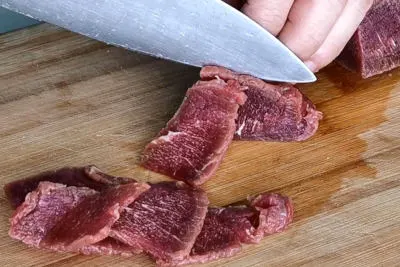
- Combine the beef slices with other ingredients in A. Marinate in the refrigerator for at least half an hour.
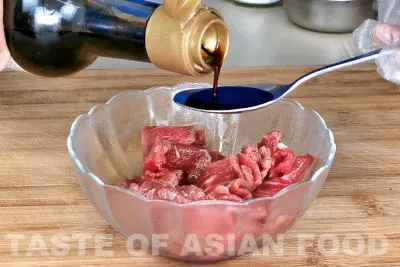
- Stir-fry the beef over medium heat with plenty of oil until it is about 90% cooked. Pour the beef and oil through a colander to remove the excess oil.
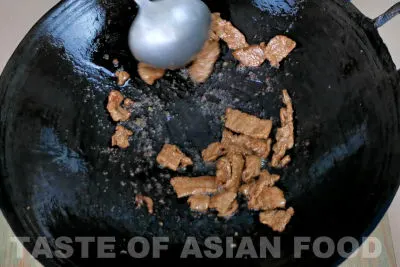
Stir-fry the ho fun
- Loosen the ho fun. Fry the ho fun over medium to high heat until slightly charred.
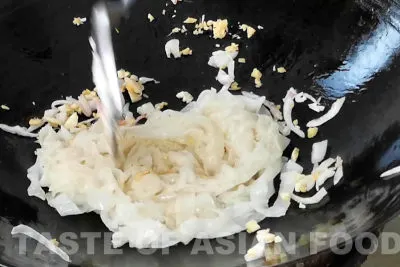
- Saute the onion and garlic and add to the ho fun. Add the bean sprouts in small batches.
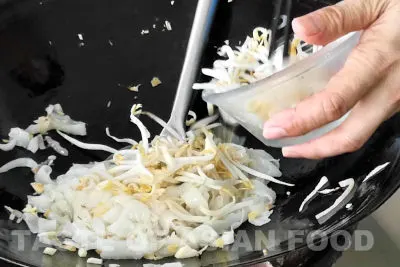
- Add seasonings B.
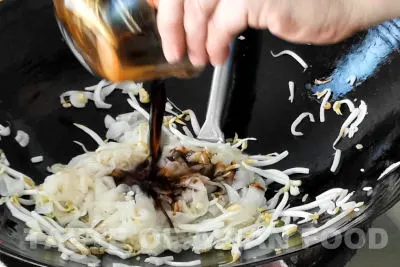
- Return the cooked beef along with the scallions to the wok.
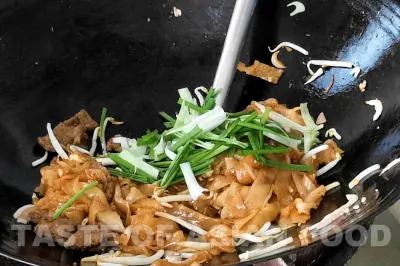
- Stir-fry over high heat for ten seconds. Dish out and serve hot.
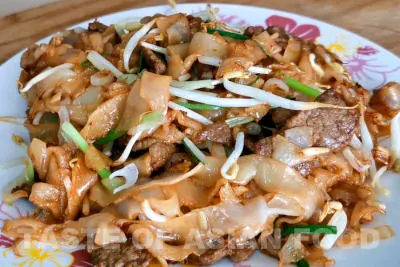
Recommended Products
As an Amazon Associate and member of other affiliate programs, I earn from qualifying purchases.
-
 GreenLife CW002044-002 Healthy Nonstick Dishwasher Oven Safe Sta Soft Grip Diamond Reinforced 8" Ceramic Non-Stick Open Frypan, 8-Inch, Black
GreenLife CW002044-002 Healthy Nonstick Dishwasher Oven Safe Sta Soft Grip Diamond Reinforced 8" Ceramic Non-Stick Open Frypan, 8-Inch, Black -
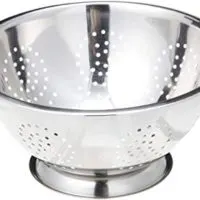 ExcelSteel 242 5-Quart Stainless Steel Colander
ExcelSteel 242 5-Quart Stainless Steel Colander -
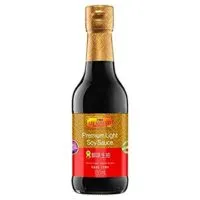 Lee Kum Kee Premium Light Soy Sauce - 150ml (5.27 fl oz)
Lee Kum Kee Premium Light Soy Sauce - 150ml (5.27 fl oz) -
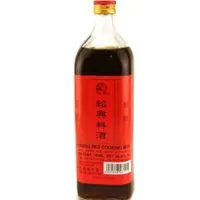 Rice Cooking Wine (Red) - 750ml (Pack of 1) by Shaohsing
Rice Cooking Wine (Red) - 750ml (Pack of 1) by Shaohsing
Nutrition Information:
Yield: 2 Serving Size: 1Amount Per Serving: Calories: 797Total Fat: 37gSaturated Fat: 3gTrans Fat: 0gUnsaturated Fat: 30gCholesterol: 0mgSodium: 2680mgCarbohydrates: 60gFiber: 45gSugar: 6gProtein: 96g
This data was provided and calculated by Nutritionix on 6/21/2020

Mei Fun Vs Chow Fun – Tips To Understand The Differences & Unique Recipes! – The Tea Cup of "Satan" ☦️
Saturday 14th of September 2024
[…] Hong Kong Beef Chow Fun […]
RIck
Monday 26th of July 2021
Recipe looks good! You mention that you can use ribeye, topside, or sirloin for the beef. What cut of beef is it that you are using in the beginning of the video? Thanks KP Kwan?
KP Kwan
Monday 26th of July 2021
It has been a while since I posted this recipe, but I vaguely remember it could be frozen sirloin.
B.Ma
Thursday 1st of October 2020
Hi kpkwan,
I found your site from your YouTube videos. I've tried a number of your recipes including this one. Every recipe I have tried from your site has been excellent, it is like eating from a restaurant. This is one of the best resources for asian cooking I have found on the internet. Thank you for sharing your recipes!
KP Kwan
Friday 2nd of October 2020
Thank you for your comment. It is my pleasure to share. Cheers!
Elsa Lock
Saturday 27th of June 2020
Hi Dear KP Kwan:
I just tried your recipe of beef-chow-fun and tastes delicious. Thanks for sharing it. Elsa
KP Kwan
Sunday 28th of June 2020
You are welcome, Elsa :)
KP Kwan
Sunday 21st of June 2020
Hi, this is KP Kwan. I am happy to see you in this comment area, as you have read through my recipe. I am pleased to reply to any questions and comments as soon as possible.